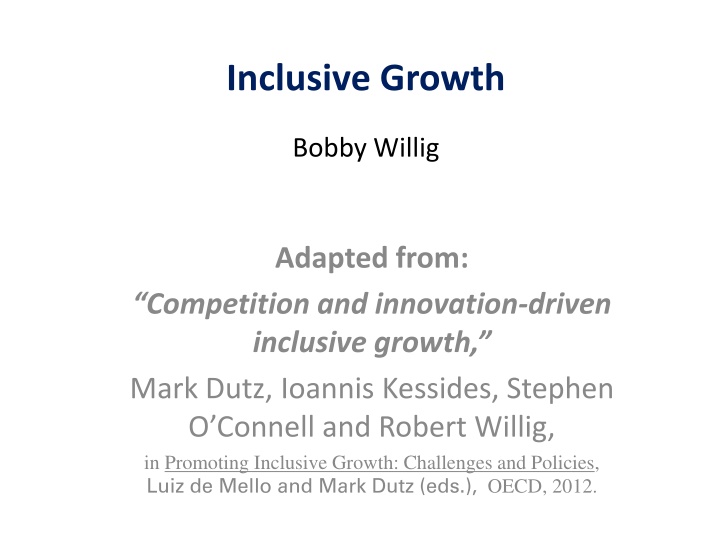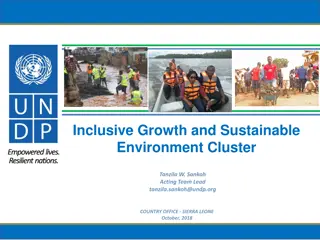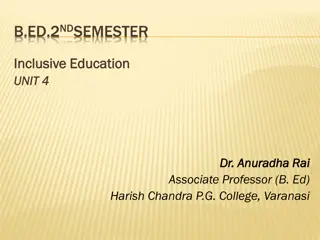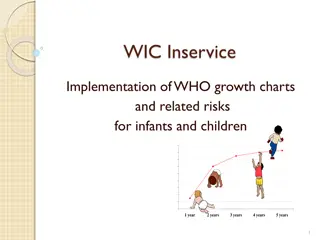
Driving Inclusive Growth Through Innovation and Productivity
Explore the importance of innovation-driven growth for inclusive development, touching on factors like total factor productivity, technology diffusion, entrepreneurship, and management efficiency. Discover examples such as solar ovens in Uganda and insights on improving overall management practices in developing countries.
Download Presentation

Please find below an Image/Link to download the presentation.
The content on the website is provided AS IS for your information and personal use only. It may not be sold, licensed, or shared on other websites without obtaining consent from the author. If you encounter any issues during the download, it is possible that the publisher has removed the file from their server.
You are allowed to download the files provided on this website for personal or commercial use, subject to the condition that they are used lawfully. All files are the property of their respective owners.
The content on the website is provided AS IS for your information and personal use only. It may not be sold, licensed, or shared on other websites without obtaining consent from the author.
E N D
Presentation Transcript
Inclusive Growth Bobby Willig Adapted from: Competition and innovation-driven inclusive growth, Mark Dutz, Ioannis Kessides, Stephen O Connell and Robert Willig, in Promoting Inclusive Growth: Challenges and Policies, Luiz de Mello and Mark Dutz (eds.), OECD, 2012.
Our Analytic Challenge Low income countries need knowledge-based innovation-driven growth. BUT conventional wisdom is that such growth disproportionately benefits investors, managers, highly skilled workers, and higher income consumers. The World Bank and OECD asked us to test empirically whether innovation-based growth is inclusive of the poor
Why Innovation-Driven Growth? Differences in measured inputs explain less than half of the enormous cross-country differences in per capita GDP A key stylized fact of development (Jones and Romer, AEJM 2010) Much of the rest is differences in total factor productivity (TFP). Countries are poor because use their inputs less efficiently The innovations and productivity brought by knowledge have caused far more than 50% of historical economic growth. Works for poor countries too!
Productivity and Innovation Innovation raises total factor productivity New products better liked raise value created by inputs Better technology and new improved processes use inputs more effectively for more of the same outputs For development, innovation need not be world new New diffusion and adaptation of existing technologies Entrepreneurship facilitation Management can be a crucial innovative technology
Solar ovens manufactured in Uganda with technology developed in Chicago and Berkeley curtails lung disease from wood burning smoke, saves fuel costs, and creates employment. 5
Overall management is worse in developing countries (slide by Bloom, Eifert, Mahajan, McKenzie and Roberts, March 1 2010 LSE/UCL seminar) # firms US 695 336 270 122 344 312 188 762 382 92 231 102 140 559 Germany Sweden Japan Canada France Italy Great Britain Australia Northern Ireland Poland Republic of Ireland Portugal Brazil India China Greece 620 524 171 2.6 2.8 3 3.2 3.4 mean of management Average country management score, manufacturing firms 100 to 5000 employees (monitoring, targets and incentives management scored on a 1 to 5 scale using the methodology developed in Bloom & Van Reenen (QJE 2007)) 6
Innovation in Management and Organization Raises Productivity Proven with controlled experiment (2011) providing management consulting to random sample of cotton textile firms in India. Firms leaders lacked information and incentives. Big gains in productivity and profits. Nick Bloom (Stanford) Benn Eifert (Berkeley) Aprajit Mahajan (Stanford) David McKenzie (World Bank) John Roberts (Stanford GSB)
Organizing inventory enables firms to substantially reduce inventory capital stock and losses. Now, after months of consulting, stock is organized, labeled, and entered into the computer with details of the type, age and location. 9
Chilean Wine Industry From no exports in 1990 to booming sector today, with substantial investments in knowledge and technology transfer for growers, viticulturalists, merchants and workers. 10
What can make innovation-driven growth inclusive?? JOBS FOR THE POOR Studies show that in developing countries, entry- level jobs for the poor are often stepping-stones out of extreme poverty. However, where there is little personal mobility or little commercial competition, unskilled jobs may lead nowhere. 11
Our Research We study from extensive data whether innovation-driven growth creates jobs for the unskilled as well as for skilled workers, and for women as well as for men. The data are from WB Enterprise surveys on a sample of over 26 000 manufacturing establishments across 71 countries (from Albania to Zambia, both OECD and developing), from 2002 to 2006. We estimate several layers of interrelated relationships: What correlates with enterprise R&D activity? What correlates with enterprise process and product innovation? What correlates with enterprise level of TFP? What correlates with enterprise level of employment growth?
2002 2003 2004 2005 2006 Number of observations (establishments) Mean Standard deviation, employment employment (persons) OECD member countries Chile Czech Estonia Germany Greece Hungary Ireland Mexico Poland Portugal Slovakia Slovenia Korea Spain Turkey OECD accession country Russian Federation OECD enhanced engagement countries x 675 123 66 448 141 326 216 2118 473 164 137 169 166 111 135 104 107 105 47 232 307 179 178 115 138 262 683 559 433 312 255 334 344 113 665 1394 296 478 354 244 x x x x x x x x x x x x x x 46 80 267 206 870 x 167 189 485 Brazil China India Indonesia South Africa Developing countries Albania Algeria Arab Republic of Egypt Armenia Belarus Benin Bih Bulgaria Cambodia Costa Rica Croatia Dominican Republic Ecuador El Salvador Ethiopia Former Yugoslav Republic of Macedonia (FYROM) Georgia Guatemala Guyana Honduras x x 1575 1601 2072 667 564 124 261 89 587 330 321 787 314 1148 1098 x x x x 71 86 59 243 128 469 96 209 58 333 215 985 229 503 159 287 251 419 538 x 460 955 222 98 150 55 69 60 298 88 131 380 465 418 39 x 122 50 110 22 171 157 409 60 164 72 84 98 107 194 x x x x x x x x x x x x x x 37 92 124 376 93 252 x 435 155 428 120 40 92 x x
2002 2003 2004 2005 2006 Number of observations (establishments) Mean Standard deviation, employment employment (persons) Jamaica Kazakhstan Kyrgyz Republic x x 50 61 82 103 88 303 101 154 179 x Kyrgyz Republic x 73 174 357 Latvia x 43 129 194 Lesotho x 35 409 831 Lithuania x 82 94 144 Lithuania x 71 103 152 Madagascar x 238 166 416 Malawi x 306 325 1265 Mali x 93 43 147 Mauritius, Republic of x 152 147 393 Moldova Moldova Mongolia Morocco Nicaragua Niger Oman Peru Philippines Romania Senegal Serbia Montenegro Sri Lanka Syrian Arab Republic Tajikistan Tajikistan Tanzania Thailand Ukraine Uzbekistan Uzbekistan Vietnam Zambia x 96 108 125 72 106 45 41 31 51 314 105 41 205 375 25 23 150 64 372 106 125 174 340 210 177 288 184 203 170 120 23 128 851 229 63 332 630 48 54 225 133 843 380 357 329 869 842 x 135 170 125 452 75 69 134 665 370 149 74 408 172 107 83 145 1385 201 x x x x x x x x x x x x x x x x x x 99 98 x x 1370 100 x
Enterprise R&D Investment Equation Influences behind variables: Appropriability IPR protection Progressivity of firm s sector elsewhere Ownership of firm foreign, governmental Ability to fund access to capital Incentives from expansion opportunities if successful innovation access to markets already competing in exports? -- business environment in home retail markets? access to funding access to capital access to labor difficulty of hiring and of firing Size of firm Age of firm
Enterprise Process & Product-Innovation Equations Influences Behind Variables Firm s ability to innovate -- R&D spend -- access to capital -- implementation skills? -have formal training program? -- access to ideas? -part of a business association -use internet? Ownership of firm foreign, governmental Incentives from expansion opportunities if successful innovation access to markets already competing in exports? -- business environment in home retail markets? access to funding access to capital access to labor difficulty of hiring and of firing Size of firm Age of firm -management quality
Measuring total factor productivity (TFP) For each 2-digit sector we estimate across the establishments a Cobb-Douglas production function Output is the real value of enterprise sales, and inputs are the real value of fixed assets, total labor costs (actual or ILO wages) and materials expense. Each firm s residual from its regression is the ln of its TFP higher values imply lower average and marginal costs of producing value. ??? = ??? + ???? + ???? + ? ? ? = ln (total factor productivity)
Enterprise TFP Equation Influences Behind Variables Firm s ability to innovate Ownership of firm foreign, governmental Incentives from expansion opportunities if successful innovation access to markets already competing in exports? -- business environment in home retail markets? access to funding access to capital access to labor difficulty of hiring and of firing Size of firm Age of firm -- new process or a new product? -- access to capital -- implementation skills? -management quality -have formal training program? -- access to ideas? -part of a business association -use internet?
Enterprise Employment Growth-Rate Equation Influences Behind the Variables Did establishment have product innovation? Did establishment have process innovation? The establishment s level of ln(TFP) The incidence of innovation among peer establishments The establishment s non-skilled production workers as % of all workers The establishment s female workers as % of all workers Establishment age and size controls Various permutations with and without other establishment controls, like those in the innovation equations. Fixed effects for country of establishment Fixed effects for sector of establishment s main product Estimate this equation on whole sample and on various subsamples by age, size and innovativeness of the enterprise.
Econometric Findings Innovation is an important driver of enterprise employment growth several percentage points out of avg of 6% for each! Innovation-driven employment growth is inclusive! innovative firms hire significantly larger shares of unskilled workers than non-innovative firms innovative firms hire significantly larger shares of female workers than non-innovative firms Innovative firms hiring is not depressed by relatively high wages, the way that hiring by non-innovative firms is.
More econometric findings significant factors for innovation and for employment growth are access to: finance (investment capital from both local banks and foreign borrowing), communications (enterprises using the internet grow significantly faster), export markets, and other essential business services such as ISO management certification, business associations and formal worker training programs. In addition, having less government ownership and having greater access to global know-how through some foreign ownership are both positive correlates of enterprise employment growth
The Competitive Business Environment Young firms (less than 5 years old) have the greatest rate of employment growth by far. Young firms innovation activities are vulnerable and sensitive to the business environment. Particularly sensitive to their countries indicators of ease of getting credit, ease of registering property and the ability to enforce business contracts. Sensitive to the overall ranking of their countries ease of Doing Business indicators.
World Banks Study of Impacts of Routine Business Regulation Ease of starting a business Hiring and firing Registering property Getting credit Mandated disclosures to protect investors Enforcing a commercial contract Ease of closing a business
Routine Business Regulation & Economic Growth + 2.3 % in annual economic growth Is impact of best versus worst regulation of business practices! Djankov, McLiesh and Ramalho, 2006. Growth of GDP per capita, 1993-2002, Quartiles in World Bank Doing Business Data Base. Impacts of education, government consumption, inflation levels etc not as sizable in these econometrics!
Firing costs (weeks of wages) RANK: Ease of Doing Business Start-up Procedures (number) Start-up Time (days) Licensing Procedures (number) Licensing Time (days) Bankruptcy Recovery rate Economy Argentina 15 32 23 288 139 36.24 101 Bosnia and Herz. 12 54 16 467 33 33.72 95 Brazil 17 152 19 460 37 12.09 121 Bulgaria 9 32 22 226 9 34.43 54 Cambodia 10 86 28 181 39 0.00 143 Chile 9 27 12 171 52 20.02 28 China 13 35 29 367 91 31.50 93 Croatia 10 45 28 278 39 28.91 124 Czech Republic 10 24 31 271 22 18.48 52 Egypt 10 19 30 263 186 16.57 165 Finland 3 14 17 56 26 89.08 14 Greece 15 38 17 176 69 46.29 109 Italy 9 13 17 284 2 39.66 82 Macedonia, FYR 10 18 18 222 22 15.47 92 New Zealand 2 12 7 184 0 68.62 2 Poland 10 31 25 322 13 27.92 75 Romania 5 11 17 242 3 19.93 49 Serbia 10 18 20 211 27 22.56 68 Singapore 6 6 11 129 4 91.35 1 Slovakia 9 25 13 272 13 48.07 36 Slovenia 9 60 14 207 40 44.91 61 Tajikistan 14.00 67 18 187 22 39.07 133 Turkey 8 9 32 232 95 9.77 91 United Kingdom 6 18 19 115 22 85.17 6 United States 5 5 18 69 0 76.97 3 Venezuela 16 141 13 276 47 6.67 164
Weaknesses of our statistical treatment Our estimated correlations are not proof of causality. Few of the many variables are fully exogenous Data are all from pretty good macroeconomic times (pre-crash), and only a snapshot of each enterprise. None of the enterprises in our data are informal. No tracking of individual employees over time. Principal next step is to secure and analyze panel data on enterprises several snapshots of each including tougher macroeconomic years.
Conclusions Innovation-driven employment growth is inclusive There seem to be productive roles for policy Better access to financing, international trade and partnerships, management practices, and internet help foster productivity, employment growth and innovation. The legal and regulatory system surrounding vulnerable (often young) firms is critical for their innovation and employment growth: property and contract protection, financial opportunities, and ease of entry and exit.
Quantitative analysis confirms that changes in labor earnings are the largest contributor to poverty reduction. In 10 of 18 Latin American countries, changes in labor income explain more than half the reduction in poverty, and in another 5 countries, more than a third. In Bangladesh, Peru, and Thailand, changes in education, work experience, and region of residence mattered, but the returns to these characteristics (including labor earnings) mattered most. Just having work was not enough, given that most people work in less developed economies. What made a difference for escaping poverty was increasing the earnings from work.
OECD accession and enhanced engagement countries; developing countries OECD member countries Variable Mean SD Mean SD Growth and innovation Annual compound employment growth rate ln (Total Factor Productivity) Whether firm introduced a new process (0/1) Whether firm introduced a new product (0/1) Whether the firm does R&D (0/1) R&D spending/total sales 5.66 3.28 29.6% 34.7% 18.9% 0.4% 21.54 2.49 45.6% 47.6% 39.2% 2.8% 6.00 3.19 36.7% 43.1% 23.0% 0.7% 23.48 2.40 48.2% 49.5% 42.1% 4.1% Establishment-level business environment Whether the firm exports (0/1) Whether the firm uses internet (0/1) Whether the firm is part of a business association (0/1) Whether the firm has ISO certification (0/1) Whether the firm offers formal training programmes (0/1) Fraction of borrowing in foreign currency Fraction of investment capital from local banks Log of (average annual wage) Whether the firm established a new foreign joint venture (0/1) Whether the firm established a new licensing agreement (0/1) 28.1% 77.8% 59.9% 26.1% 47.2% 23.0% 13.9% 9.54 6.6% 8.4% 44.9% 41.6% 49.0% 43.9% 49.9% 33.5% 25.4% 0.89 24.8% 27.8% 28.0% 59.8% 59.2% 21.1% 47.3% 11.9% 20.1% 8.08 6.4% 9.0% 44.9% 49.0% 49.2% 40.8% 49.9% 29.7% 30.9% 1.79 24.5% 28.7% Enterprise characteristics Whether the firm is government owned (0/1) Whether the firm is foreign owned (0/1) Whether the firm is incorporated (0/1) Fraction of workforce comprised of management employees Fraction of workforce comprised of skilled production employees Fraction of workforce comprised of unskilled production employees Fraction of workforce comprised of female employees 1.6% 9.5% 57.8% 5.4% 51.5% 23.0% 17.4% 12.6% 29.4% 49.4% 12.0% 30.3% 28.9% 23.9% 6.8% 12.4% 52.6% 9.9% 38.9% 34.3% 28.2% 25.2% 32.9% 49.9% 14.7% 30.1% 31.6% 30.1% Sectoral and country business environment US 4 digit ISIC sector average R&D intensity 1.7% 1.8% 1.6% 1.4%
Variable Underlying survey question Growth and innovation Annual compound employment growth rate The following table refers only to permanent workers of your plant: {Average number of workers}, {Average number of workers 3 years ago} Has your company undertaken any of the following initiatives in the last three years? {Introduced new technology that has substantially changed the way that the main product is produced} Has your company undertaken any of the following initiatives in the last three years? {Developed a major new product line} Whether firm introduced a new process (0/1) Whether firm introduced a new product (0/1) Whether the firm does R&D (0/1) R&D spending/total sales How much did your establishment spend on design or R&D last year? {>0} How much did your establishment spend on design or R&D last year? / Please provide the following information on your establishment s production, sales and expenses. {Total sales} Establishment-level business environment Whether the firm exports (0/1) Whether the firm uses internet (0/1) Whether the firm has external auditor (0/1) Whether the firm is part of a business association (0/1) Whether the firm has ISO certification (0/1) Whether the firm offers formal training programs (0/1) Fraction of borrowing in foreign currency Fraction of investment capital from local banks What percent of your establishment s sales are:{exported directly}+{exported indirectly (through a distributor)} Does your enterprise regularly use e-mail or a website in its interactions with clients and suppliers?: {E-mail}, {Website} Does your establishment have its annual financial statement reviewed by an external auditor? Is your establishment/firm a member of a business association or chamber of commerce? Has your firm received ISO (e.g. 9000, 9002 or 14000) certification? Do you offer formal (beyond on the job ) training to your permanent employees? What share of your total borrowing (loans, accounts payable) is denominated in foreign currency? Please identify the contribution over the last year of each of the following sources of financing for your establishment s: ii) New investments (i.e. new land, buildings, machinery and equipment): {Local commercial banks} The following table refers only to permanent workers of your plant: {Total wages} / {Average number of workers} Has your company undertaken any of the following initiatives in the last three years? {Agreed to a new joint venture with foreign partner} Has your company undertaken any of the following initiatives in the last three years? {Obtained a new licensing agreement} Average annual wage Whether the firm established a new foreign joint venture (0/1) Whether the firm established a new licensing agreement (0/1) Enterprise characteristics Whether the firm is government owned (0/1) Whether the firm is foreign owned (0/1) Whether the firm is incorporated (0/1) Fraction of workforce comprised of management employees Fraction of workforce comprised of skilled production employees Fraction of workforce comprised of unskilled production employees Average number of workers: {Unskilled production workers}, {Total} Fraction of workforce comprised of female employees What percentage of your firm is owned by: {Government/State} What percentage of your firm is owned by: {Private Sector: a) foreign} What is the current legal status of your firm? {Publicly listed company; Private held, limited company} Average number of workers: {Management}, {Total} Average number of workers: {Skilled production workers}, {Total} The following table refers only to permanent workers of your plant: {Average number of workers of which: % female}






















